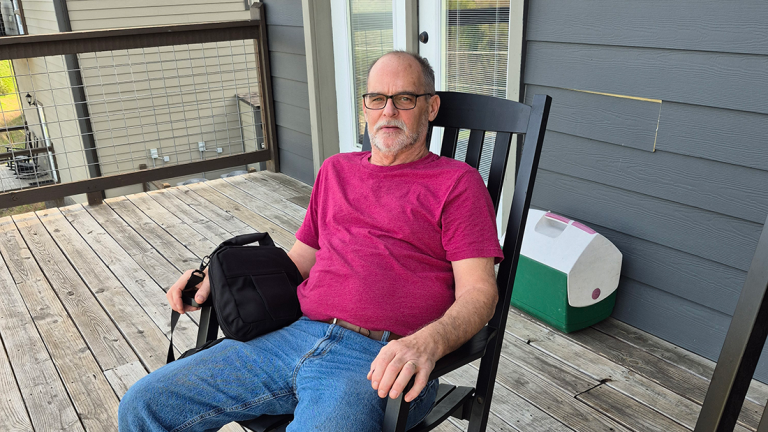In most cases, heart failure is a progressive condition that prevents the body’s vital organs from getting the blood and oxygen they need. But advanced medical devices and better medical care are helping people with heart failure live longer and better.
At age 67, Michael Long has outlived most males on his father’s side of the family. Heart disease has taken too many relatives far too soon. Unfortunately, Michael has it, as well.
While he hasn’t escaped the roots of his family tree, he is working to free himself from them. The St. Elizabeth Healthcare Advanced Heart Failure Management Center is guiding his efforts.
Problems Years in the Making
For years, Michael dealt with high blood pressure, high cholesterol and abnormal heart rhythms. Doctors think he might have encountered a heart-damaging viral infection at one point. Ultimately, he developed cardiomyopathy, a progressive heart muscle condition that prevents the heart from pumping efficiently.
Michael received a pacemaker to help regulate his heart rate and an implantable cardioverter defibrillator that shocks the heart if it detects dangerous rhythms. He’s taken various medicines, as well.
“They were monitoring me, but I kept having issues,” Michael says. “Shortness of breath, no energy, chest pain — all that good stuff.” Eventually, his heart was pumping only 15% to 20% of the blood it should be.
A referral to the Heart Failure Center at St. Elizabeth led to a new treatment recommendation: a left-ventricular assist device (LVAD).
The LVAD Device
An LVAD is a battery-operated mechanical pump. While a heart transplant may be the preferred treatment for severe heart failure in appropriate patients, it rarely happens quickly. An LVAD can ease symptoms and buy patients time. For those who don’t qualify for a transplant, it may be a long-term treatment that offers a similar life expectancy.
During open-heart surgery, a cardiac surgeon attaches the LVAD device, which is about the size of a baseball, to your heart’s left ventricle. The LVAD helps pump oxygenated blood throughout your body.
Patients wear a controller unit outside the body and two battery packs. These outer components connect to the pump by a driveline, an electrical cable passing through the skin.
Choosing LVAD Patients
There are stringent criteria to qualify for an LVAD. A team of experts conducts various tests and evaluates each patient.
“It’s a very in-depth process before they can say, ‘OK, we know this will work, so we’ll go ahead and do it,’” says Michael.
There’s a lot to learn, too.
“I had a binder that was probably three inches thick with information,” he recalls. “There was constant education.”
It all paid off, however. In November 2024, during a seven-plus-hour procedure, Michael received his device. It was one of 36 LVADs implanted at St. Elizabeth since the LVAD program began in 2020. Renowned Cardiothoracic Surgeon, Dr. Mario Castillo-Sang, MD, performed his surgery.
Living with an LVAD
Michael is hoping to get a heart transplant soon. In the meantime, he changes his batteries twice a day and always has spares on standby. At night, he plugs his device into a wall unit.
He eats a low-sodium diet, goes to cardiac rehab and regularly gets dressing changes over his driveline. He also gets weekly tests to measure the clotting time of his blood, something that’s essential with an LVAD because of the risk of clots forming. Doctor visits are frequent.
“He’s an excellent patient,” says Casey Behne, RN, who, together with Rob Bayer, RN, are Michael’s VAD coordinators. Behne and Bayer are Michael’s go-to LVAD experts who’ve been at his side from day one. “He follows every detail, as does his wife.” Caregiver support is vital for successful outcomes.
Despite a few setbacks, Michael says he’s feeling better. His shortness of breath improved almost immediately. And his energy level, although not yet where he’d like it to be, is increasing.
“It’s just a long, slow process,” he says.
A Second Family
Michael eagerly anticipates his return to “normal.” It’s little things he’s most looking forward to — doing jobs around the house, helping on his son’s farm, chasing his grandkids.
He’s especially thankful for his wife. “She’s been right there for everything,” Michael says. “She pretty much keeps me in line.”
But he’s also grateful for his second family at St. Elizabeth, especially Behne and Bayer.
“The heart failure team tells you once we get you, you’re part of our family. And that’s exactly how they treat you,” he says.
Along with his wife, Michael’s St. Elizabeth team is the part of his family tree he expects to pull him through.
Visit the Advanced Heart Failure Management Center webpage to learn more.

